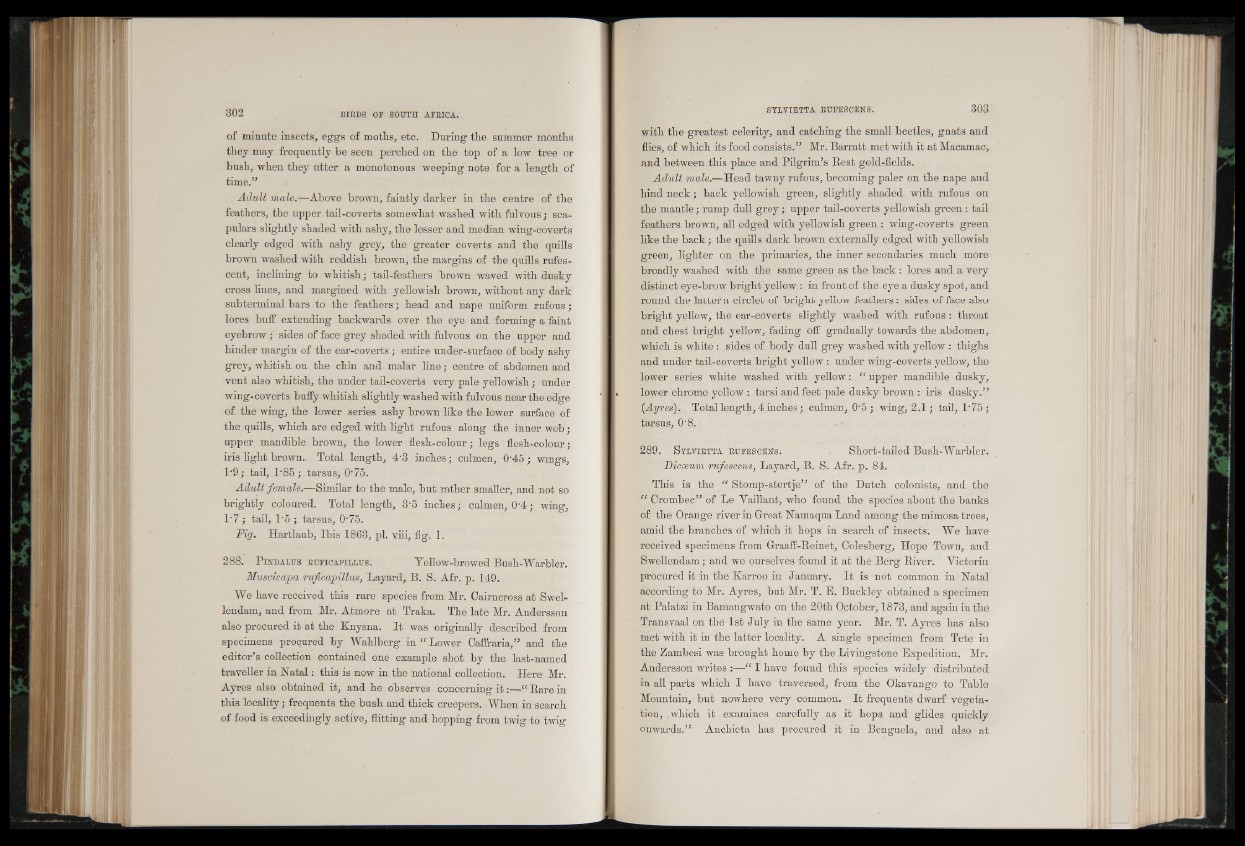
of minute insects, eggs of moths, etc. During the summer months
they may frequently be seen perched on the top of a low tree or
bush, when they utter a monotonous weeping note for a length of
time.”
Adult male.—Above brown, faintly darker in the centre of the
feathers, the upper tail-coverts somewhat washed with fulvous; scapulars
slightly shaded with ashy, the lesser and median wing-coverts
clearly edged with ashy grey, the greater coverts and the quills
brown washed with reddish brown, the margins of the quills rufes-
cent, inclining to whitish; tail-feathers brown waved with dusky
cross lines, and margined with yellowish brown, without any dark
subterminal bars to the feathers; head and nape uniform rufous;
lores buff extending backwards over the eye and forming a faint
eyebrow; sides of face grey shaded with fulvous on the upper and
hinder margin of the ear-coverts; entire under-surface of body ashy
grey, whitish on the chin and malar line; centre of abdomen and
vent also whitish, the under tail-coverts very pale yellowish; under
wing-coverts buffy whitish slightly washed with fulvous near the edge
of the wing, the lower series ashy brown like the lower surface of
the quills, which are edged with light rufous along the inner web;
upper mandible brown, the lower flesh-colour; legs flesh-colour;
iris light brown. Total length, 4'3 inches; culmen, 0'45; wings,
1’9; tail, 1-85 ; tarsus, 0'75.
Adult female.—Similar to the male, but rather smaller, and not so
brightly coloured. Total length, 3'5 inches; culmen, 0 '4 ; wing,
1-7 ; tail, 1‘5 ; tarsus, 0‘75.
Fig. Hartlaub, Ibis 1863, pi. viii, fig. 1.
288. P indalus r u f ic a p il lu s . Yellow-browed Bush-Warbler.
Muscicapa ruficapillus, Layard, B. S. Afr. p. 149.
We have received this rare species from Mr. Caimcross at Swel-
lendam, and from Mr. Atmore at Traka. The late Mr. Andersson
also procured it at the Knysna. It was originally described from
specimens procured by Wahlberg in “ Lower Caflraria,” and the
editor's collection contained one example shot by the last-named
traveller in Natal: this is now in the national collection. Here Mr.
Ayres also obtained it, and he observes concerning i t :—“ Rare in
this locality; frequents the bush and thick creepers. When in search
of food is exceedingly active, flitting and hopping from twig to twig
with the greatest celerity, and catching the small beetles, gnats and
flies, of which its food consists.” Mr. Barratt met with it at Macamac,
and between this place and Pilgrim's Rest gold-fields.
Adult male.—Head tawny rufous, becoming paler on the nape and
hind neck ; back yellowish green, slightly shaded with rufous on
the mantle ; rump dull grey ; upper tail-coverts yellowish green : tail
feathers brown, all edged with yellowish green : wing-coverts green
like the back ; the quills dark brown externally edged with yellowish
green, lighter on the primaries, the inner secondaries much more
broadly washed with the same green as the back : lores and a very
distinct eye-brow bright yellow : in front of the eye a dusky spot, and
round the latter à circlet of bright yellow feathers : sides of face also
bright yellow, the ear-cóverts slightly washed with rufous : throat
and chest bright yellow, fading off gradually towards the abdomen,
which is white : sides of body dull grey washed with yellow : thighs
and under tail-coverts bright yellow : under wing-coverts yellow, the
lower series white washed with yellow : “ upper mandible dusky,
lower chrome yellow : tarsi and feet pale dusky brown : iris dusky.”
(Ayres). Total length, 4 inches ; culmen, 0‘5 ; wing, 2.1 ; tail, I -75;
tarsus, 0’8.
289. S y l v ie t t a r u f e s c e n s . , Short-tailed Bush-Warbler.
Ficoeum rufescens, Layard, B. S. Afr. p. 84.
This is the “ Stomp-stertje” of the Dutch colonists, and the
“ Crombec” of Le Yaillant, who found the species about the banks
of the Orange river in Great Namaqua Land among the mimosa trees,
amid the branches of which it hops in search of insects. We have
received specimens from Graaff-Reinet, Colesberg, Hope Town, and
Swellendam ; and we ourselves found it at the Berg River. Victoria
procured it in the Karroo in January. I t is not common in Natal
according to Mr. Ayres, but Mr. T. B. Buckley obtained a specimen
at Palatzi in Baniangwato on the 20th October, 1873, and again in the
Transvaal on the 1st July in the same year. Mr. T. Ayres has also
met with it in the latter locality. A single specimen from Tete in
the Zambesi was brought home by the Livingstone Expedition. Mr.
Andersson writes :—“ I have found this species widely distributed
in all parts which I have traversed, from the Okavango to Table
Mountain, but nowhere very common. It frequents dwarf vegetation,
.which it examines carefully as it hops and glides quickly
onwards.” Anchieta has procured it in Benguela, and also at